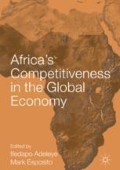Abstract
In this chapter the competitiveness of Accra, Ghana, is compared to cities in other regions of the world. Integrating the resource-based view of the firm with other perspectives, the study theorizes the city as a bundle of resources including knowledge and capabilities that can confer some advantages on firms located within it. The study utilizes data from the World Bank Enterprise Surveys to validate the arguments, bringing to the fore issues of resource advantages within specific locations, especially cities. In doing so, it makes a significant contribution, establishing a link between location theory (agglomeration and industrial complexes), the new economic geography, the new growth theory and resource-based theory (including capabilities).
References
Acheampong, G., & Dana, L.-P. (2015). Liability of Foreignness in Fast-Expanding Markets: Evidence from Ghana. Thunderbird International Business Review, 10(10), 1–11.
Asiedu, E. (2002). On the Determinants of Foreign Direct Investment to Developing Countries: Is Africa Different? World Development, 30(1), 107–119.
Barney, J. (1991). Firm Resources and Sustained Competitive Advantage. Journal of Management, 17(1), 99–120. https://doi.org/10.1177/014920639101700108. February 28, 2013.
Barney, J. B. (2001). Is the Resource-Based “View” a Useful Perspective for Strategic Management Research? Yes. The Academy of Management Review, 26(1), 41–56.
Bernerth, J. B., & Aguinis, H. (2016). A Critical Review and Best-Practice Recommendations for Control Variable Usage. Personnel Psychology, 69(1), 1–55. https://doi.org/10.1111/peps.12103.
Boschma, R. (2004). Competitiveness of Regions from an Evolutionary Perspective. Regional Studies, 38(9), 1001–1014. https://doi.org/10.1080/0034340042000292601. March 11, 2013.
Brouwer, A. E., Mariotti, I., & van Ommeren, J. N. (2004). The Firm Relocation Decision: An Empirical Investigation. The Annals of Regional Science, 38(2), 335–347. https://doi.org/10.1007/s00168-004-0198-5. March 27, 2013.
Buame, S. C. K., & Acheampong, G. (2015). International Retail Firm Acceptance: Beware of the Flattery. International Journal of Business and Globalisation, 14(3), 292–309.
Ciccone, A., & Peri, G. (2006). Identifying Human-Capital Externalities: Theory with Applications. Review of Economic Studies, 73, 381–412.
KPMG. (2016). Africa’s Increasing Global Competitiveness. South Africa: Johannesburg.
Eifert, B., Gelb, A., & Ramachandran, V. (2008). The Cost of Doing Business in Africa: Evidence from Enterprise Survey Data. World Development, 36(9), 1531–1546. http://linkinghub.elsevier.com/retrieve/pii/S0305750X08000934. May 21, 2013.
Esteve-Pérez, S., & Mañez-Castillejo, J. A. (2006). The Resource-Based Theory of the Firm and Firm Survival. Small Business Economics, 30(3), 231–249. https://doi.org/10.1007/s11187-006-9011-4. April 8, 2013.
Fairlie, R. (2005). An Extension of the Blinder-Oaxaca Decomposition Technique to Logit and Probit Models. Journal of Economic and Social Measurement, 30(4), 305–316. http://iospress.metapress.com/index/E1GQMW31W5D4ENKA.pdf. December 12, 2014.
Florida, R. (2002). The Economic Geography of Talent. Annals of the Association of American Geographers, 94(4), 734–755.
Gagnon, S. (1999). Resource-Based Competition and the New Operations Strategy. International Journal of Operations & Production Management, 19(2), 125–138.
Gordon, I. R., & McCann, P. (2000). Industrial Clusters: Complexes, Agglomeration and/or Social Networks? Urban Studies, 37(3), 513–532. https://doi.org/10.1080/0042098002096. March 19, 2013.
Grant, R. (1991). The Resource-Based Theory of Competitive Advantage: Implications for Strategy. California Management Review, 33(3), 114.
Hansen, H., & Rand, J. (2014). The Myth of Female Credit Discrimination in African Manufacturing. Journal of Development Studies, 50(1), 81–96. https://doi.org/10.1080/00220388.2013.849337. December 13, 2014.
Heyneman, S. P. (2010). Education and Development: A Return to Basic Principles. Development, 53(4), 518–521. https://doi.org/10.1057/dev.2010.85. May 20, 2013.
Kitson, M., Martin, R., & Tyler, P. (2004). Regional Competitiveness: An Elusive yet Key Concept? Regional Studies, 38(9), 991–999. https://doi.org/10.1080/0034340042000320816. March 16, 2013.
Kumar, T. R. (2002). The Impact of Regional Infrastructure Investment in India. Regional Studies, 36(2), 194–200. https://doi.org/10.1080/00343400120114771. March 27, 2013.
Low, D. R., Chapman, R. L., & Sloan, T. R. (2007). Inter-Relationships Between Innovation and Market Orientation in SMEs. Management Research News, 30 (12), 878–891.
Lucas, R. E. (1988). On the Mechanics of Economic Development. Journal of Monetary Economics, 22, 3–42.
Malmberg, A., & Maskell, P. (2002). The Elusive Concept of Localization Economies: Towards a Knowledge-Based Theory of Spatial Clustering. Environment and Planning A, 34(3), 429–449. Retrieved March 27, 2013, from http://www.envplan.com/abstract.cgi?id=a3457
McCann, P., & Shefer, D. (2003). Location, Agglomeration and Infrastructure. Papers in Regional Science, 83(1), 177–196. https://doi.org/10.1007/s10110-003-0182-y. March 25, 2013.
Obeng-Odoom, F. (2009). The Future of our Cities. Cities, 26(1), 49–53. https://doi.org/10.1016/j.cities.2008.11.001.
Parilla, J., & Trujillo, J. L. (2015). South Africa’s Global Gateway: Profiling the Gauteng City-Region’s Interntional Competitiveness and Connections.
Ropega, J. (2011). The Reasons and Symptoms of Failure in SME. International Advances in Economic Research, 17(4), 476–483. https://doi.org/10.1007/s11294-011-9316-1. June 6, 2014.
Sinning, M., Hahn, M., & Bauer, T. (2008). The Blinder-Oaxaca Decomposition for Nonlinear Regression Models. The Stata Journal, 8(4), 480–492. Retrieved December 12, 2014, from http://ageconsearch.umn.edu/bitstream/122616/2/sjart_st0152.pdf
Sorensen, J. B., & Stuart, T. E. (2000). Aging, Obsolescence, and Organizational Innovation. Administrative Science Quarterly, 45(1), 81. Retrieved March 31, 2013, from http://www.jstor.org/stable/2666980?origin=crossref
The Economist Intelligence Unit. (2013). Hot Spots 2025: Benchmarking the Future Competitiveness of Cities. http://www.citigroup.com/citi/news/2013/130604a.pdf
Author information
Authors and Affiliations
Editor information
Editors and Affiliations
Rights and permissions
Copyright information
© 2018 The Author(s)
About this chapter
Cite this chapter
Acheampong, G., Damoah, O.B. (2018). Theorizing Cities as Sources of Firm Competitive Advantage: Accra in Comparative Perspective. In: Adeleye, I., Esposito, M. (eds) Africa’s Competitiveness in the Global Economy. AIB Sub-Saharan Africa (SSA) Series. Palgrave Macmillan, Cham. https://doi.org/10.1007/978-3-319-67014-0_3
Download citation
DOI: https://doi.org/10.1007/978-3-319-67014-0_3
Published:
Publisher Name: Palgrave Macmillan, Cham
Print ISBN: 978-3-319-67013-3
Online ISBN: 978-3-319-67014-0
eBook Packages: Business and ManagementBusiness and Management (R0)

